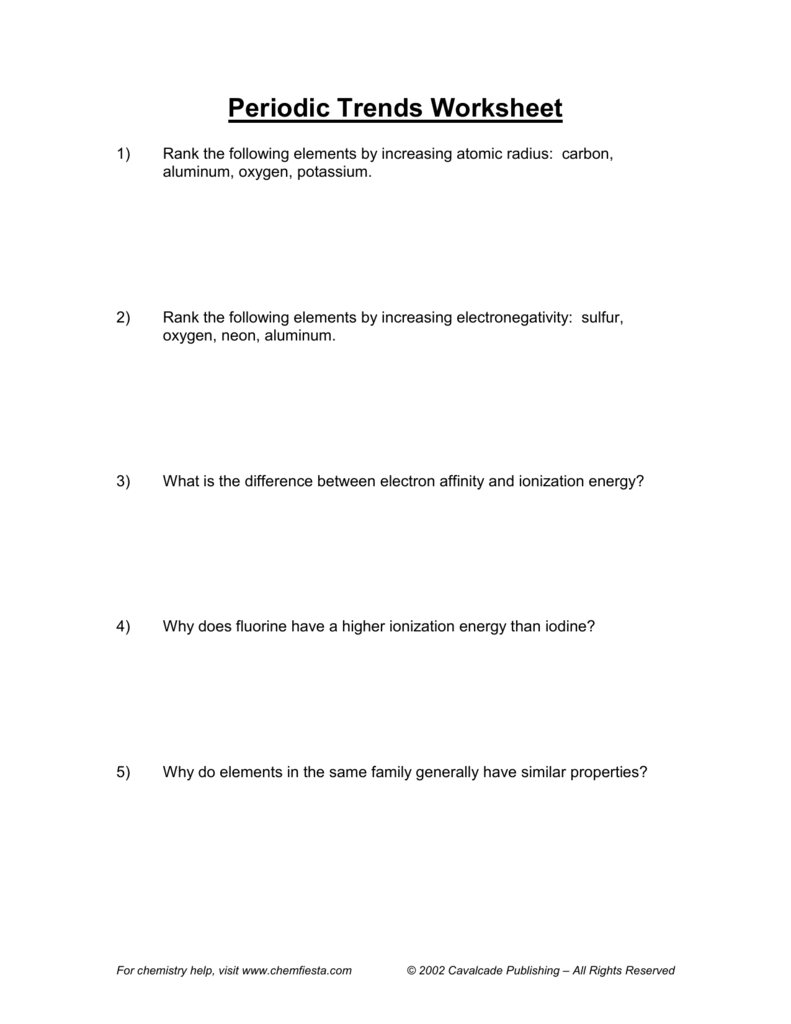
alkali, and alkaline-earth metals, tend to be good reducing agents, as their valence electrons, whose radial orbit DEFINES the atomic radius, tend to be readily oxidized. The atomic radius is a measure of the size of the electron cloud, or the region where electrons can be found. Arrows to show increasing periodic trends or decreasing periodic trends. In the Periodic Trends Gizmo, you will explore this relationship and how it affects the properties of different elements. On the other hand, the larger elements, i.e. A summary worksheet activity of the periodic table trends including: Electronegativity, Electron Affinity, Ionization Energy, Ionic Radius, Atomic Radius and Shielding Effect. nitrogen, fluorine, oxygen, TEND to be very powerful oxidants, and this is also manifested by their small atomic size. Excluding the Noble Gases, the smaller atoms from the right hand side, i.e. It follows that the SMALLEST atoms derive the right of the Table as we face it. Of course, the diagram shows NO data (it should do so), but the relative size of the atoms across the Period, and down the Group is clear. And the best metric that illustrates this trend is the well-known diminution of atomic radii across the Period from left to right? And of course, we should look at some data.


Now it is a fact that the nuclear charge is SHIELDED very poorly by incomplete electronic shells. Compare your predictions to the values given in model 1 below. Atomic Radius: 0.079 nm Electronegativity: 2.10 1st Ionization Energy: 1312.0 kJ/mol C- Carbon (diamond) Atomic Number: 6 Density: 3.51 g/mL Melting Point: - ✬ (enter 3000✬) Conductivity (x 107-1 Atomic Radius: 0.091 nm Electronegativity: 2.55 1st Ionization Energy: 1086.4 kJ/mol He- Helium Atomic Number: 2 Density: 0.0001785g/mL Melting. The chemistry and atomic structure of the elements is a contest between (i) nuclear charge, conveniently represented by #Z_"the atomic number"#, and (ii) shielding by other electrons. Atomic number Atomic radius (pm 1012 m) Melting point ( C) Boiling point ( C) Electronegativity (Pauling scale) Sodium (Na) 11 186 98 883 0.9 Magnesium (Mg) 12 1 1.2 Aluminium (Al) 13 1 1.5 Silicon (Si) 2355 1.8 Phosphorus (P) 15 110 44 280 2.1 Sulfur (S) 16 104 119 445 2. Predict the trend for the atomic radius for the elements in group I and group II of the periodic table. #"Increase in atomic radii down a Group, a column of the Periodic"#"Table."#


 0 kommentar(er)
0 kommentar(er)
